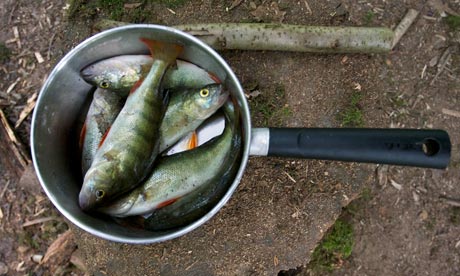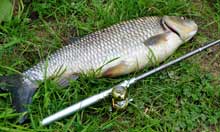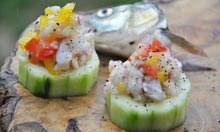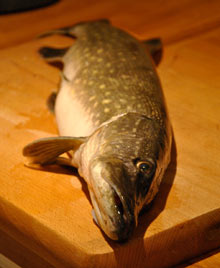Millions of anglers catch fish only to put them straight back again. Isn't it time we rediscovered the culinary potential of freshwater species?

While Hugh Fearnley-Whittingstall has been raising awareness about sea fishing with his Fish Fight campaign, it seems an opportune time to cast an eye inland to our native freshwater species: the pike, perch, zander, chub, carp, bream and gudgeon that swim largely uneaten in our lakes and rivers.
Britain has a rich history of consuming freshwater species. In the past those who didn't live near the sea ate whatever they could coax out of inland waterways. Monastic gardens and manor houses almost always had a fishpond or moat where freshwater species were farmed for Friday fish suppers and Lenten feasts.
You would struggle to find any of the species above displayed on a fishmonger's slab in the UK these days, but they all make a worthy feast. Some cultures have never forgotten this - the British angling press is frequently peppered with tales of resourceful eastern Europeans taking prize carp, something of a delicacy in their part of the world, home for tea. I know of one person who was holding a 20lb carp aloft for the all-important trophy shot on the River Ouse in Sussex when a Polish gentleman approached and offered him £20 for it. The fisherman politely declined and slipped the carp back into the water, but fair play to the prospective buyer; you can't get much fresher than that.
With an estimated three million anglers in the UK regularly pulling fish out of the water only to put them straight back, why is it that we don't we eat more of our native freshwater species? One of the main reasons must be that we are a nation of sporting folk; freshwater species are targeted on both quality and quantity criteria. Specimen hunters invest plenty of time and money in the pursuit of large individuals of species such as pike, carp, barbel and the non-native catfish. The reward is twofold: an epic fight and the possibility of a new personal best or even a record-breaker.
 Chub. Photograph: Nick Weston
Chub. Photograph: Nick Weston On the other hand, match fishermen go for quantity and any species is welcome regardless of size. All these perfectly edible fish are put into a keep net to be weighed up at the end of the day before being released back into the water. Many cultures would view this practice as verging on insanity, but it is our quality of life and today's convenience culture that has turned fishing in the UK from a necessity into a mass-participation sport. Only those fishing for trout, sea trout and salmon seem to take something home for the table.
People are also nervous about the legality of fishing. There's no need; in England and Wales as long as you are in possession of a £27 rod licence and have permission from the water's owner, the Environment Agency states that on any given day an angler may remove 15 small (up to 20cm) native species including barbel, chub, common bream, common carp, crucian carp, dace, grayling, perch, pike, roach, rudd, silver bream, smelt, tench and zander (non-native) as well as one pike of up to 65cm and two grayling of 30-38cm (the full rules are here (pdf), and a note on Scottish law here).
Another reason this subject is often approached with apprehension is that many people believe freshwater fish will taste muddy. Fish from free-flowing waters don't tend to suffer from this problem, although those from still waters can. As seen in an episode of River Cottage Forever, the only antidote is to cleanse the fish through a de-mudification programme of 3-4 days in a spring-fed tank. I'm afraid the bathtub just won't cut it.
To ensure these fish find their way into your kitchen, you have to catch them yourself. So what to catch? I've been an avid fisherman since childhood and over the years I have eaten my way through a number of freshwater species. My favourite used to be eel, but as the number of young eels returning to European rivers has fallen by 95% it is now illegal to remove any caught by rod and line, but there are plenty of other options.
Perch are a beautiful fish, green scaled with black stripes down their flanks, an impressive spiked dorsal fin and a ferocious pack-hunter mentality. Although nearly wiped out in UK waters in the 1970s and 1980s by a lethal virus, thankfully they have made a remarkable comeback. Perch have firm white flesh similar to bass. To cook, simply de-scale, fillet, toss in seasoned flour and pan fry with lemon juice: a recipe the French refer to as filet de perche.
 Chub cerviche. Photograph: Tom Kevill-Davies
Chub cerviche. Photograph: Tom Kevill-Davies The chub is deemed to be an inedible fish, Izaak Walton referred to it as being "full of forked bones, the flesh is not firm, but short and tasteless". And I could not agree more. That is, if you cook it. It was my friend Tom (The Hungry Cyclist) that first suggested giving chub the ceviche treatment and it worked a treat.
If any freshwater species is guilty of tasting muddy, then it is the carp. Due to increasing pressure on our saltwater stocks and adoration from Eastern Europeans in the UK, consumption of this fish is beginning to rise for the first since the middle ages. Again, the flesh is firm and meaty and stands up to a variety of different ways of cooking, although baking is the best method. The first certified organic farmed carp are now available from Jimmie & Penny Hepburn of Devon-based Aquavision. Their method to rid these fish of any hint of mud is to transfer them into natural spring fed tanks a week before harvest.
 Pike. Photograph: Nick Weston
Pike. Photograph: Nick Weston The sinister pike is another excellent eating fish. Not only are they cannibals, regularly feasting on other pike often more than half their own size, as Ted Hughes described in his poem Pike. They also have almost unlimited confidence: there have been reports of attacks on humans and in one instance a large pike was found that had choked to death on a swan. Their mouths contain a series of backward-pointing teeth: once something goes in, it's not coming out. Pike can also grow to alarming size - the British record presently stands at a mighty 46lbs 13oz.
Even dead pike have a secret weapon; once cooked they possess a substantial number of Y-shaped bones along the fillet. Once removed they have a mild taste which is quite pleasant, and I recommend referring to Larousse for recipes such as pike quenelles and pike au beurre blanc.
As with growing and eating your own vegetables, catching and cooking a fish you have wrestled out of the depths gives a feeling of deep satisfaction. With the pressure on our oceans at an all time high, perhaps it is time to look at less familiar options. For those who do fish, please consider tasting your catch. And if you don't, consider taking it up: you'll be in a position to get your hands on some of the freshest possible fish.
Many of the fish I've mentioned above have been staple foods in the past, so why are we so put off by them now? If you've tucked into some of our lesser-known freshwater fish, how did you cook them? And more importantly, would you consider eating them more often?
No comments:
Post a Comment